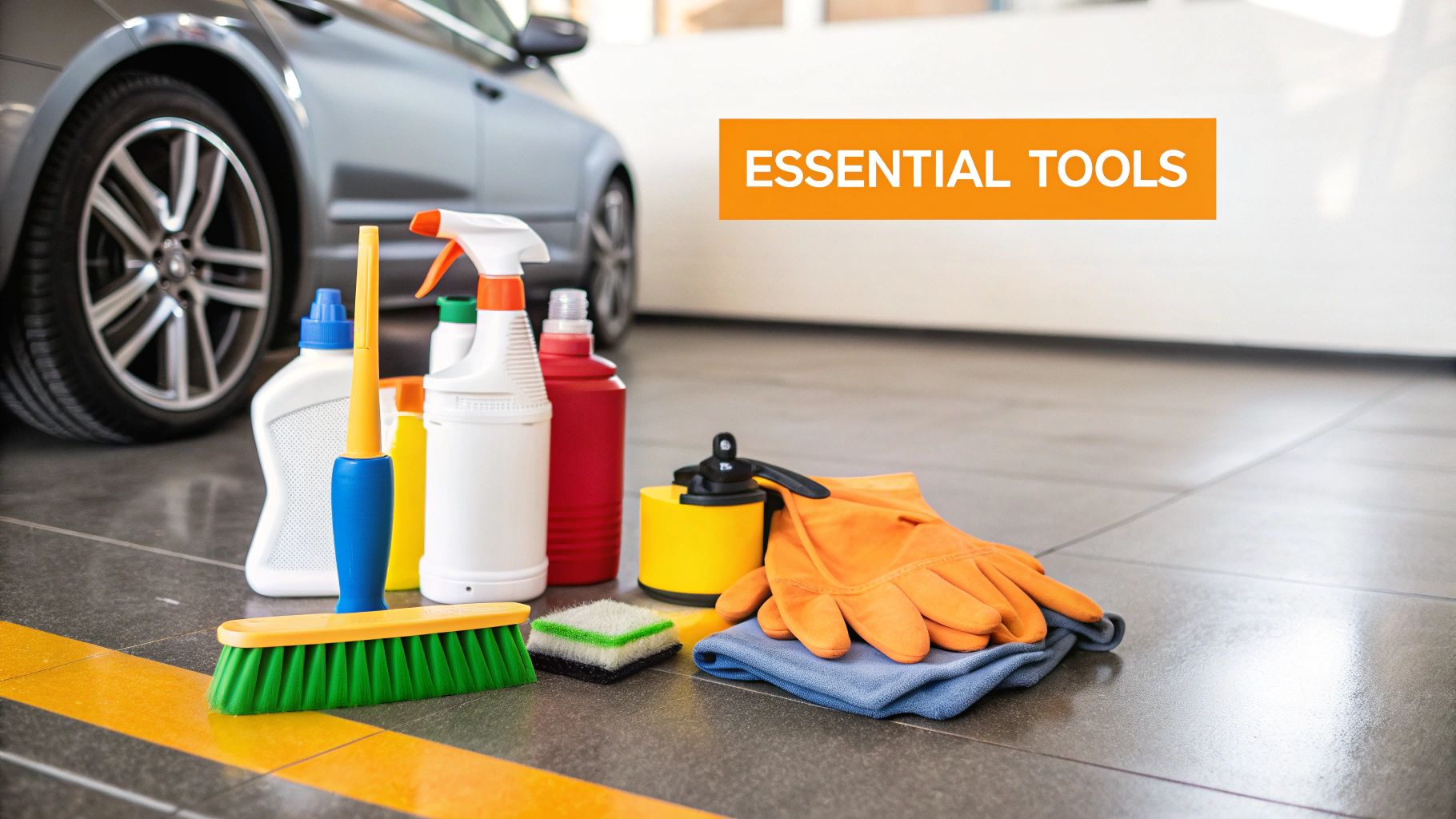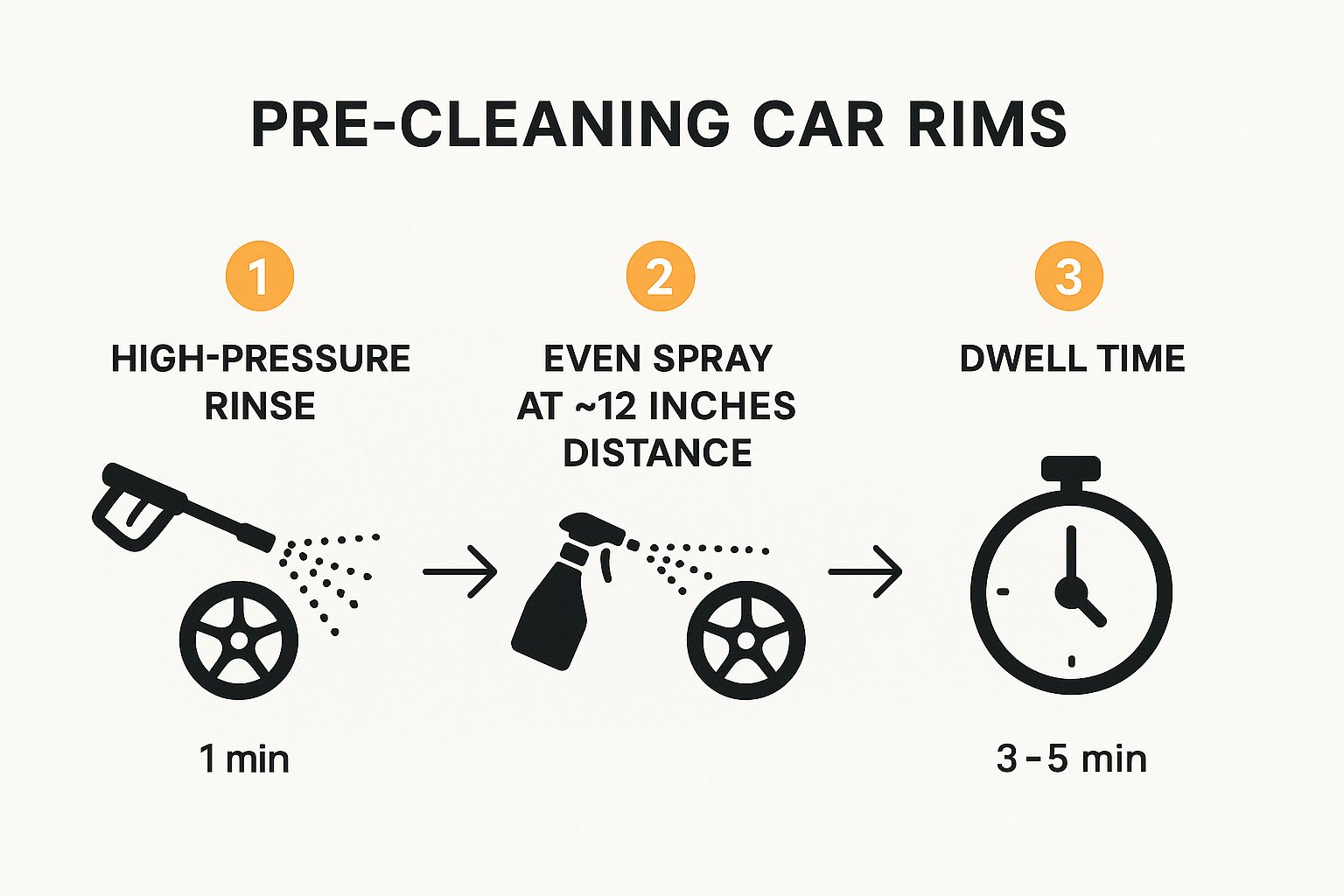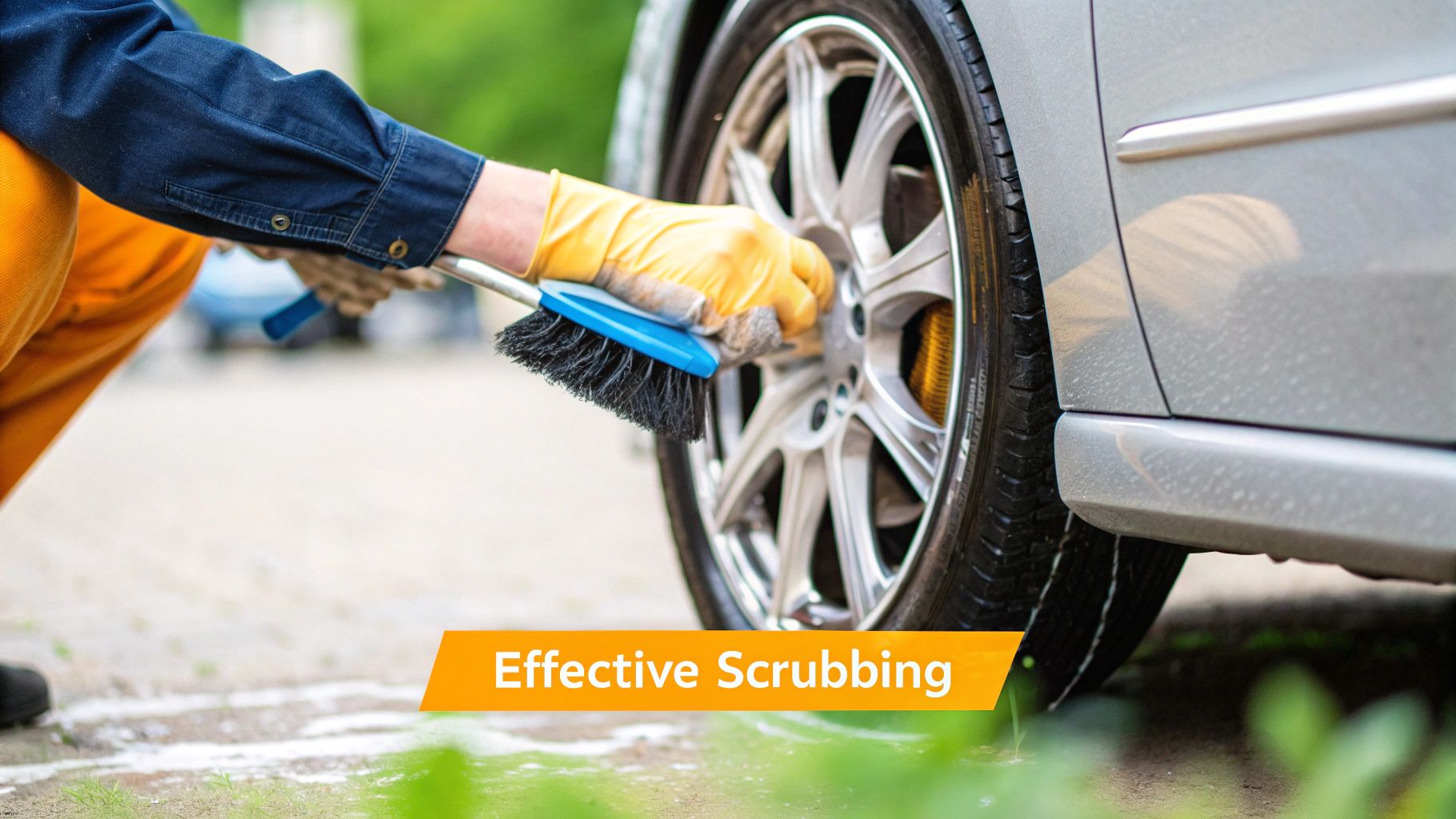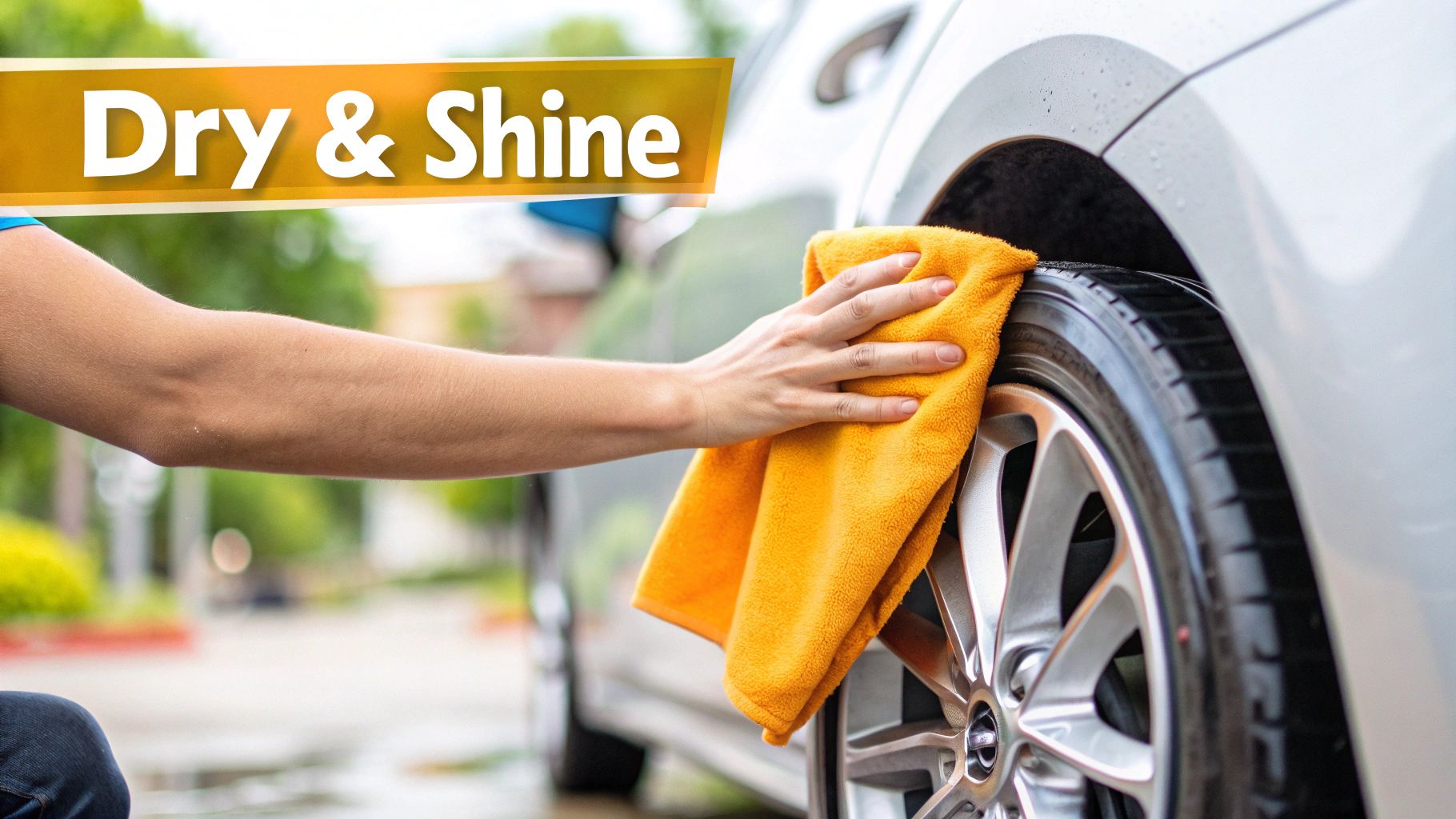Why Clean Rims Matter More Than You Think
Sparkling clean rims instantly elevate a car's appearance. However, their importance goes beyond just aesthetics. It's not simply about vanity; it's about safeguarding your investment and ensuring the longevity of your wheels. Those seemingly insignificant black specks gathering on your rims are actually tiny, corrosive brake dust particles.
Over time, this brake dust, made up of metallic shavings, can etch into your wheel's finish, causing permanent damage. Imagine leaving a rusty nail on a painted surface. The rust will eventually spread, damaging the paint.
Brake dust, if left unaddressed, will similarly erode your rims, diminishing their shine and ultimately their structural integrity. This is particularly true for aluminum alloy wheels, which are highly susceptible to corrosion.
Regular cleaning is not just about maintaining a glossy appearance; it's about preventing costly repairs or replacements in the future.
The Impact of Neglect and the Benefits of Proper Care
The repercussions of neglecting your rims can be significant. Corrosion can lead to pitting and flaking, ultimately necessitating costly refurbishing or even total wheel replacement. Furthermore, neglected rims can lower your car's resale value.
On the other hand, maintaining clean rims can considerably extend their lifespan, saving you money over time. You might be interested in: How to master car detailing from our blog map
The global market for tire and wheel cleaners reflects the increasing understanding of the importance of rim care. Valued at approximately USD 2.45 billion in 2022, the market is projected to reach about USD 2.99 billion by 2030, growing at a CAGR of around 2.54%. This growth demonstrates a steady demand for specialized cleaning products, fueled by the growing emphasis on vehicle aesthetics and maintenance. Find more detailed statistics here: Tire & Wheel Cleaners Market Report
Different Rims, Different Approaches
The optimal method for cleaning car rims depends on the material. Different rim materials, from high-end alloys to standard steel, require specific care. Using incorrect cleaning products or methods can harm delicate finishes, creating additional problems.
Harsh chemicals can strip the protective coating from chrome rims, while abrasive brushes can scratch painted or powder-coated surfaces. Understanding the particular needs of your rim material is essential for effective and safe cleaning. This meticulous approach ensures that your cleaning efforts enhance, rather than detract from, the beauty and longevity of your wheels.
The Perfect Rim Cleaning Arsenal: Tools That Actually Work

Selecting the right tools and products is the first step towards achieving flawlessly clean rims. This isn't simply about aesthetics; it's about protecting your wheels from long-term damage. A well-informed approach will also make your cleaning process more efficient.
Essential Cleaning Supplies
Having the right tools makes all the difference. A high-quality wheel cleaner, designed for your specific rim type, is crucial. Opt for a pH-balanced formula to avoid damaging delicate finishes. You'll also want to invest in a good set of wheel brushes.
These specialized brushes are designed to reach intricate areas, like behind spokes and around lug nuts, ensuring a thorough clean. Here are some other essential supplies:
-
Microfiber wash mitts and towels: These are gentle on your rims and highly effective at trapping dirt and grime.
-
A sturdy bucket: Use a dedicated bucket for your wheel cleaning solution to prevent cross-contamination with other car wash products.
-
A pressure washer (optional): A pressure washer can significantly speed up the cleaning process, especially for heavily soiled rims. Interested in learning more about pressure washers and other cleaning products? Check out our guide on products.
Choosing the Right Wheel Cleaner
With so many wheel cleaners available, selecting the correct one can be overwhelming. Understanding a few key factors can simplify the process. Consider your wheel's finish (chrome, aluminum, painted, etc.) and choose a cleaner specifically designed for it. This prevents damage and ensures optimal cleaning.
Think about the level of cleaning required. For light dirt and brake dust, a milder cleaner may suffice. For heavier buildup, you might need a more powerful cleaner. Remember, the right tools and techniques are essential for effectively cleaning your car rims.
The Importance of Proper Brushes
Using the correct brushes is just as important as the cleaner itself. Soft-bristled brushes are ideal for delicate finishes, while stiff-bristled brushes are better suited for heavy grime and brake dust. This targeted approach minimizes the risk of scratches and maximizes cleaning effectiveness.
Investing in various brush sizes allows you to access all areas of your rims, including those tight spots that are often missed.
The following table provides a comparison of various rim cleaning products, highlighting their strengths and weaknesses for different rim types and levels of soiling.
Rim Cleaning Products Comparison
A comprehensive comparison of different wheel cleaning products by type, effectiveness, safety for various rim materials, and price range.
| Product Type | Best For | Safe On | Avoid On | Price Range | Effectiveness Rating |
|---|---|---|---|---|---|
| Acidic Wheel Cleaner | Heavy brake dust and grime | Steel wheels | Chrome, aluminum, and clear-coated wheels | $10-$20 | 5/5 (for heavy duty cleaning) |
| pH-Neutral Wheel Cleaner | Regular cleaning and light brake dust | Most wheel types including chrome, aluminum, clear-coated, and painted | N/A | $15-$25 | 4/5 (for regular maintenance) |
| Alkaline Wheel Cleaner | Tough dirt and road grime | Most wheel types, but test on a small area first | Polished aluminum | $12-$22 | 4/5 (for moderate soiling) |
| Iron Removing Wheel Cleaner | Removing embedded iron particles and brake dust | Most wheel types, but test on a small area first | N/A | $20-$30 | 5/5 (for iron removal) |
As you can see, different wheel cleaners are formulated for specific purposes and rim materials. Choosing the right product is essential for achieving optimal results and avoiding damage.
The car cleaning products market, including rim cleaners, is growing, reflecting an increased focus on car care. The market was valued at $3.99 billion in 2021 and is projected to reach $6.78 billion by 2031, growing at a CAGR of 5.7%. This growth encompasses various products contributing to a vehicle's appearance and longevity. Learn more about the growing car cleaning products market. Maintaining your car, including the rims, is crucial for both safety and aesthetics, and it's a key part of any comprehensive car maintenance checklist.
Master Class: The Best Way to Clean Car Rims Step-by-Step
Transforming dirty wheels into sparkling rims is a straightforward process. This detailed guide, drawn from professional detailing experience, will help you achieve a showroom-worthy shine.
Pre-Cleaning Preparation: The Foundation of a Sparkling Clean
Preparation is essential before applying any cleaner. This crucial step, often overlooked, significantly impacts the final result. Never clean hot wheels, as the heat can cause cleaning solutions to dry too quickly and leave streaks or spots. Let your wheels cool down. Start with a thorough pre-rinse using a strong stream of water to remove loose dirt and debris, which will reduce your overall cleaning time. This pre-cleaning process can be visualized in three simple steps:

This infographic illustrates the essential pre-cleaning steps. This initial rinse-and-dwell process softens and loosens stubborn grime, preparing the rims for a more effective deep clean. This ensures the following cleaning stage focuses on dissolving embedded contaminants, not just redistributing surface dirt.
Applying the Wheel Cleaner: Precision and Technique
Now, apply your chosen wheel cleaner. Having the right tools is essential for maintaining pristine wheels. Consider researching resources like Shopify theme customization tips for ideas on maintaining a professional look. Ensure even coverage, spraying the cleaner from approximately 12 inches away to prevent splatter. Let the cleaner dwell for the recommended time, typically 3-5 minutes. This dwell time is crucial for allowing the cleaner to penetrate and break down stubborn grime and brake dust. For intricate wheel designs, agitate the cleaner with a dedicated wheel cleaning brush to reach hard-to-access areas behind spokes and around lug nuts.
Rinsing and Drying: The Final Touches for a Flawless Finish
Rinse thoroughly from the top of the wheel down to prevent streaking and ensure all cleaner residue is removed. Dry your rims immediately after rinsing to prevent water spots. A microfiber drying towel is ideal because its absorbency and soft texture leave rims spotless and scratch-free. This attention to detail in the rinsing and drying process makes the difference between a good and a truly professional-looking clean.
Maintaining the Shine: Protecting Your Investment
After cleaning, consider applying a wheel sealant or wax. This protective layer acts as a barrier against brake dust and road grime, making future cleaning easier and faster. Following these steps and incorporating regular maintenance into your routine will keep your car rims looking their best. This not only enhances your vehicle's appearance but also preserves the value and integrity of your wheels—a smart long-term investment. Regular upkeep prevents the buildup of stubborn grime, saving you time and effort later. Consistent care is the best way to maintain that perfect shine and protect your wheels from the damaging effects of brake dust and road grime.
Wheel Material Matters: Tailoring Your Approach
Different wheel materials require specific cleaning approaches. This isn't just about aesthetics; it's about preserving the integrity of your wheels and protecting your investment. Understanding the nuances of each material is key to choosing the right cleaning method.
Aluminum Alloy Wheels: Balancing Cleaning and Protection
Aluminum alloy wheels are popular for their lightweight and stylish appearance. However, they're susceptible to corrosion from brake dust. The best approach involves using a pH-balanced wheel cleaner. Avoid acidic cleaners, which can etch the surface.
Surprisingly, some household products can ruin aluminum wheels. Highly alkaline solutions like oven cleaner can cause irreversible damage. Opt for a dedicated wheel cleaner and a soft-bristled brush. This gently removes grime without scratching. A sealant designed for aluminum can protect against future brake dust buildup.
Chrome Wheels: Maintaining That Mirror Shine
Chrome wheels require a specialized approach to maintain their shine. Use a pH-balanced cleaner designed for chrome. This prevents microscopic etching that dulls the finish.
Avoid abrasive cleaners and brushes, which can scratch. Use a soft microfiber wash mitt or a dedicated chrome wheel brush. For stubborn stains, a chrome polish can restore luster. Regular rinsing and a protective sealant are crucial for preventative care.
Painted and Powder-Coated Wheels: Gentle Yet Effective Cleaning
Painted or powder-coated wheels offer various color and finish options. Gentle cleaning methods are essential to preserve the coating.
Use a pH-neutral car wash soap or a wheel cleaner designed for painted surfaces. Avoid harsh chemicals and abrasive brushes. A soft microfiber wash mitt or a soft-bristled brush cleans effectively without scratching. Chipping or fading indicates a need for a specialized approach or refinishing.
Custom Finishes: Extra Care for Unique Wheels
Custom finishes like anodized or diamond-cut wheels require extra care. Anodized wheels have a protective oxide layer that harsh chemicals can damage. Diamond-cut wheels have intricate machined surfaces prone to scratches.
Use a pH-neutral cleaner and a very soft brush. Avoid harsh chemicals or abrasive materials. Always test any cleaning product on a small, inconspicuous area first.
The Growing Importance of Specialized Wheel Care
The demand for customized and high-performance vehicles has fueled growth in the wheel care market. The Tire Wheel Cleaners Market in 2022 was valued at USD 2.71 Billion and is projected to grow at a CAGR of 3.6% by 2028. This growth highlights the importance of specialized cleaning products. Learn more: Tire Wheel Cleaners Market Report.
Understanding and catering to your wheel material's specific needs ensures longevity and enhances your vehicle's appearance. Correct cleaning methods maintain both their appearance and value.
Conquering Stubborn Wheel Nightmares

Even with regular cleaning, wheels can become coated in stubborn grime. This section explores how to tackle those seemingly impossible cleaning challenges that regular car washes just can't handle. We'll delve into the most effective methods for cleaning car rims and removing ingrained dirt.
Removing Baked-On Brake Dust: A Professional Approach
Baked-on brake dust is a common problem for car owners. These dark, embedded particles aren't just an eyesore; they can damage your wheels over time due to their corrosive nature. Professional detailers typically use a multi-stage approach, beginning with a dedicated wheel cleaner specifically designed to dissolve metallic particles. Iron removers can also be very effective. However, it's essential to choose a product that is compatible with your wheel type. Always test any cleaner on a small, inconspicuous area first to avoid damaging delicate finishes.
Dissolving Embedded Metal: A Surprising Household Solution
Sometimes, even dedicated wheel cleaners struggle to remove embedded metal particles. Surprisingly, white vinegar can be an effective and safe solution. Its mild acidity helps to break down the metallic bonds without harming most wheel finishes. However, avoid using vinegar on chrome wheels. Also, never mix vinegar with other cleaning products, as this can create dangerous chemical reactions. For example, mixing vinegar and bleach produces toxic chlorine gas.
Restoring Dull, Oxidized Wheels: A Step-by-Step Process
Dull, oxidized wheels have lost their shine and can make your car look older than it is. Restoring their original luster requires a progressive cleaning process. This often involves using a metal polish designed for your specific wheel type. For example, aluminum wheels require a dedicated aluminum polish. Heavily oxidized wheels, however, may require professional restoration. For related products and information, check out our guide on collections for a safe and effective approach.
Addressing Other Stubborn Contaminants
Besides brake dust and oxidation, various other contaminants can affect your wheels. These include tree sap, road tar, and hard water deposits. Each contaminant requires a specific cleaning method for effective removal. Tree sap and road tar, for instance, often respond well to a dedicated tar remover. Calcium deposits from hard water can frequently be removed with white vinegar or a specialized calcium remover. Identifying the contaminant is the first step in choosing the right cleaning solution. This ensures the most effective cleaning while minimizing the risk of damage.
The following table outlines some of the most stubborn rim cleaning challenges and provides solutions for tackling them:
Stubborn Rim Problems and Solutions
This table identifies common difficult rim cleaning challenges and offers the most effective solutions for each issue.
| Problem | Appearance | Cause | Recommended Product | Technique | Prevention Tips |
|---|---|---|---|---|---|
| Baked-on Brake Dust | Dark, embedded particles | Metallic residue from brake pads | Wheel cleaner designed for metallic particles, Iron remover | Spray on, allow to dwell, agitate with a brush, rinse thoroughly | Regular cleaning, wheel sealant |
| Embedded Metal | Small, shiny specks | Metal shavings from brakes or road debris | White vinegar (not for chrome), Dedicated metal remover | Apply vinegar or remover, let sit, scrub, rinse | Wheel sealant |
| Oxidation | Dull, faded finish | Chemical reaction with the environment | Metal polish specific to wheel type | Apply polish, buff with a soft cloth | Regular cleaning, wheel wax |
| Tree Sap | Sticky residue | Tree resin | Tar remover | Apply tar remover, let sit, wipe away | Wash car promptly after parking under trees |
| Road Tar | Black, sticky spots | Asphalt and road debris | Tar remover | Apply tar remover, let sit, scrub, rinse | Regular cleaning |
| Calcium Deposits | White, chalky film | Hard water drying on wheels | White vinegar, Calcium remover | Apply vinegar or remover, let sit, scrub, rinse | Dry wheels after washing |
By understanding the nature of each contaminant and using the correct cleaning products and techniques, you can keep your wheels looking their best. Regular cleaning and preventative measures, like applying a wheel sealant or wax, can also help minimize the buildup of stubborn grime, keeping your wheels in pristine condition.
Beyond Clean: Protection Strategies That Actually Last

Cleaning your car rims is essential. But truly maintaining that pristine shine requires a more proactive approach. This section explores protection strategies that not only keep your rims looking their best but also significantly reduce the need for frequent, deep cleaning. Protecting your rims is an investment in both their appearance and their longevity.
The Protective Trio: Ceramic Coatings, Waxes, and Sealants
Several products can help extend the life of your freshly cleaned rims. Ceramic coatings offer a highly durable, long-lasting barrier against the elements, including brake dust, road grime, and UV damage. These coatings bond with the wheel's surface, creating a hydrophobic layer that repels dirt and water. This makes future cleaning significantly easier.
Wheel waxes, while not as durable as ceramic coatings, provide a deep, glossy shine and a good level of protection against contaminants. They do, however, require more frequent reapplication. Sealants offer a middle ground between waxes and ceramic coatings, balancing durability, protection, and ease of application.
Choosing the Right Protection for Your Wheels
The best product for your rims depends on your budget and desired level of protection. Ceramic coatings offer premium, long-lasting protection, minimizing cleaning frequency and maximizing protection against environmental factors. This makes them a great choice for those seeking the ultimate protection.
For a more budget-friendly option, wheel waxes offer a good balance of protection and shine. Keep in mind that they will need to be reapplied more often. Sealants provide a solid compromise, offering decent durability and protection at a moderate price point.
Establishing a Maintenance Routine: Effortless Upkeep
Even with protective coatings, regular maintenance is key to preserving your rims' appearance. A simple quick-clean routine, tailored to your driving conditions, will make a big difference. If you frequently drive in dusty or dirty environments, a weekly rinse with a pH-neutral car wash soap and a microfiber mitt is recommended.
For those who drive less frequently or in cleaner conditions, a bi-weekly or even monthly quick clean may be sufficient. This regular light cleaning prevents the buildup of stubborn grime, reducing the need for more intensive cleaning sessions.
Seasonal Protection: Tackling Specific Challenges
Each season presents unique challenges for your rims. Winter brings road salt, a corrosive element that can quickly damage unprotected wheels. Regularly rinsing your wheels during winter, especially after driving on salted roads, will help minimize salt buildup and prevent corrosion.
Summer, on the other hand, can lead to increased brake dust due to higher temperatures and more frequent braking. Applying a wheel sealant or wax before the summer months provides an extra layer of protection against this increased brake dust accumulation.
Achieving Long-Term Rim Protection
Long-term rim protection is achievable with the right combination of protective products and a consistent maintenance routine. Consider your driving habits, environment, and budget when choosing a product and establishing a cleaning schedule. This proactive approach will minimize the need for time-consuming deep cleans and help maintain that showroom shine year-round.
Ready to experience the effortless clean and long-lasting protection of SwiftJet? Upgrade your car wash routine with the SwiftJet Car Wash Foam Gun today! Experience the difference between a quick rinse and a truly deep clean, while protecting your rims for months to come.
